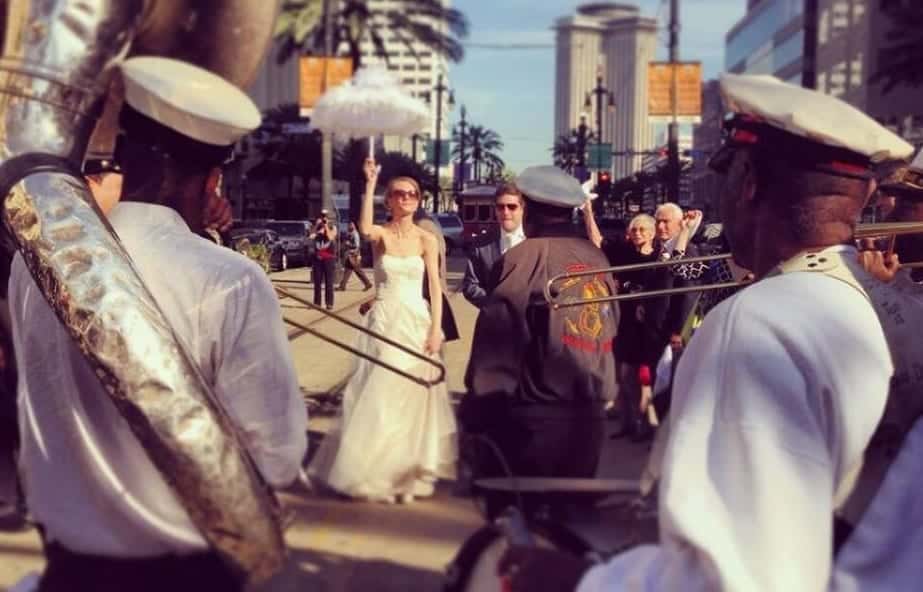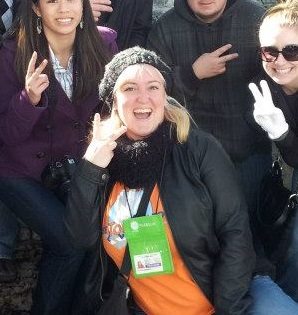This post will explain the second lines in New Orleans, where and when to find them, and how to join in.
We also explain their history and evolution.
- What is a Second Line?
- Can I Join?
- Second Line Schedules
- History and Evolution
- Other Things to Do in NOLA
WHAT IS A SECOND LINE?
The second line is a foot parade led by a brass band.
The most famous ones are jazz funerals, where during a single event you can hear dirges to mourn the loss of a loved one and upbeat songs to celebrate their life.
This apparent contradiction runs through all kinds of second lines - a community dancing and singing to celebrate shared joys and shake off shared burdens.
Any significant event can inspire a second line, from weddings to festivals to protests.
There are also weekly events on Sundays for most of the year. The tradition originated and still centers on black neighborhoods, and it comes from the mixing of West African and European cultures.
At the front of the procession are the main line or first line, the band, and the people at the heart of the event, whether that’s a wedding party or the members of a social club.
Behind them comes the second line, which gives the whole event its name - these are the general attendees and the crowd that had assembled spontaneously during the walk.
Participants might carry handkerchiefs and decorated parasols to both keep cool and accentuate their dance moves.
There’s no single right way to dance during a second line, but experienced participants do a style called buckjumping which may overflow onto the sidewalks, nearby front porches, and the tops of cars along the route.
Today, second lines are carefully planned events – local law requires that they follow a predetermined route and have a police escort.
And that means it’s sometimes possible for visitors to see or participate in one.
CAN I JOIN IN?
The answer is yes – usually. Crowd participation is part of the tradition, but there’s some etiquette worth knowing beforehand.
First, if the band is playing a slow dirge and the members of the main line are walking in a slow, deliberate step, then you’re witnessing the first and most solemn phase of a jazz funeral.
This is a rare event for a visitor to see, and the most respectful thing to do is stand along the side of the path silently.
After some time, a jazz funeral will change from mournful to upbeat music, and at this point, it’s more acceptable to join, although it’s still best to defer to locals.
Second, visitors in NOLA who have organized a second line don’t always fully understand the tradition they’re participating in.

So the members of a wedding second line in the French Quarter, for example, might feel put off if strangers join in.
If you do participate, it’s best to treat a second line like any other line – join from the back.
You may also see some impressive costumes or some great dancing and want to take a photo or a video.
Here, again, let the locals set cues for you - some participants in the second lines don’t want to be photographed.
At the very least, it’s important to leave their path clear.
HOW DO I FIND A SECOND LINE?
Usually, it takes some planning.
If you’re staying in the French Quarter you may stumble across a second line by chance, but it’s probably organized by and for visitors.
These include weddings, bachelor/bachelorette parties, and sometimes even business events.
Traditional second lines organized by locals mostly take place far from the touristic beaten path.
Visitor-friendly second lines tend to be publicized through In the Streets, a program of the local jazz and heritage radio station, WWOZ.

Besides time and route information, In the Streets also hosts interviews with second-line leaders.
Detailed information is usually available not much more than a week in advance.
The second lines promoted for visitors fall into a few types.
Some of the festivals celebrating New Orleans music and culture, like Jazz Fest, French Quarter Fest, and Satchmo Fest, include second lines open to the public.
You can find out about local festivals through publications like the Gambit Weekly.
If a major figure from New Orleans has died, there will often be a large memorial second line, separate from the funeral, so the public can mourn while still giving the deceased person’s nearest and dearest some privacy.
Finally, there’s an organized second line every Sunday from late August through June, with occasional breaks for a major holiday.
Each one is put together by a different social organization.
These second lines are like wandering block parties – they move along a plotted route from bar to bar. They go on for hours – generally from 1:00 pm - 5:00 pm or so.
Occasionally they’ll pass near the French Quarter or Garden District, but it’s rare.
So if you’re interested in attending a second line, your best bet is to find the starting point (via In the Streets), arrive a little early, and move with it.
Bring cash – everything you need by way of food and drink will be provided along the route by local businesses and street vendors, and sometimes a collection is taken up along the way to help cover the costs of the event.
HISTORY AND EVOLUTION
Second lines have their deepest roots in West African dances performed as part of weekly Sunday traditions dating back to New Orleans’ origins.
After the American Civil War, formerly enslaved people organized societies – including Masonic lodges, men’s and women’s groups, and what we call Social Aid – which pooled resources to see to the needs of their members.
Often, these groups supported a brass band, whose choice of instruments, musical repertoire, performance style, and dress derived from American military bands.
Those bands would then play at the club’s major events, including the funerals of members.
At the turn of the 20th century, these bands affected the evolving sound of jazz and created their own versions of jazz standards.
Like the second lines themselves, the rhythms of jazz music are connected to West African music, and many of the dance moves seen in the second lines today come from the same source.
Other musical innovations, like funk, R&B, and hip-hop, have found their way into the brass band sound so that today’s brass bands can often play material from across a century and a half of music history.






